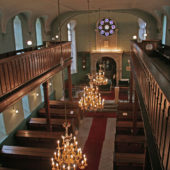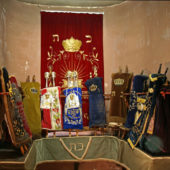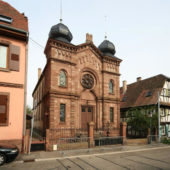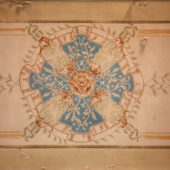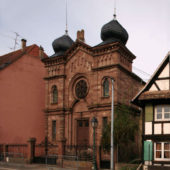Spared from destruction in World War II For more than four centuries (1346-1791), Jews had been banished to the French countryside, forbidden to live in cities. With the French Revolution of 1789 and subsequent emancipation of the Jews in 1791, synagogue construction flourished for about a century throughout the Alsace region, particularly in small towns and villages where the area’s largely Ashkenazi Jewish population once resided.
The Wolfisheim synagogue is a product of this period and the existing building was constructed in 1897 to replace an earlier structure. Though a relatively modest building, the synagogue is recognizable for its stately, reddish colored masonry and its prominent onion domed towers.
Its arch shaped windows, in particular, and other features borrow heavily from a German architectural innovation of the mid 19th century know as Rundbogenstil. Characterized by round arches, this style has a more utilitarian emphasis, placing construction and planning ahead of ornamentation or other architectural flourishes. A rose window, topped by a triangular pediment and framed on either side by rectangular towers, completes the synagogue’s exterior.
Meanwhile, the interior features ornate chandeliers and a wooden balustrade running along a balcony supported by wood columns. A stained glass window, or oculus, helps to illuminate the interior above the ark while the ceiling is painted in a simple gold flower pattern. Floral motifs also accent the walls and ceilings throughout the main hall.
By 1831, the French state, which had long supported Christian clergy, also began to support rabbis. This allowed small Jewish congregations across France to concentrate more wealth on synagogue construction instead of paying expenses for their rabbis. In Wolfisheim, this helped lead to the construction of the 1837 building. However, by the late 19th Century, this structure was no longer sufficient to meet the needs of a congregation that had grown to almost 250.
Wolfisheim’s Jewish population went into slow decline as the 20th century dawned with more people abandoning rural life and moving to nearby Strasbourg and other French cities for better opportunities. When the Nazis arrived in Alsace in 1940, they destroyed Strasbourg’s main synagogue but left most Alsatian synagogues, including Wolfisheim’s, untouched. In many cases this was because locals disguised the buildings or deceived the Germans as to their true origins. In the case of Wolfisheim, the town’s mayor convinced the Germans that blowing up the synagogue, located in the town’s center, would be too damaging to the rest of the village.
Though still used for weekly prayer services as well as for holidays and special occasions such as weddings, the synagogue has begun to show its age with peeling paint and cracks in ceilings and walls. Restoration work budgeted at 107,500 Euros ($138,266) began in early 2008.

